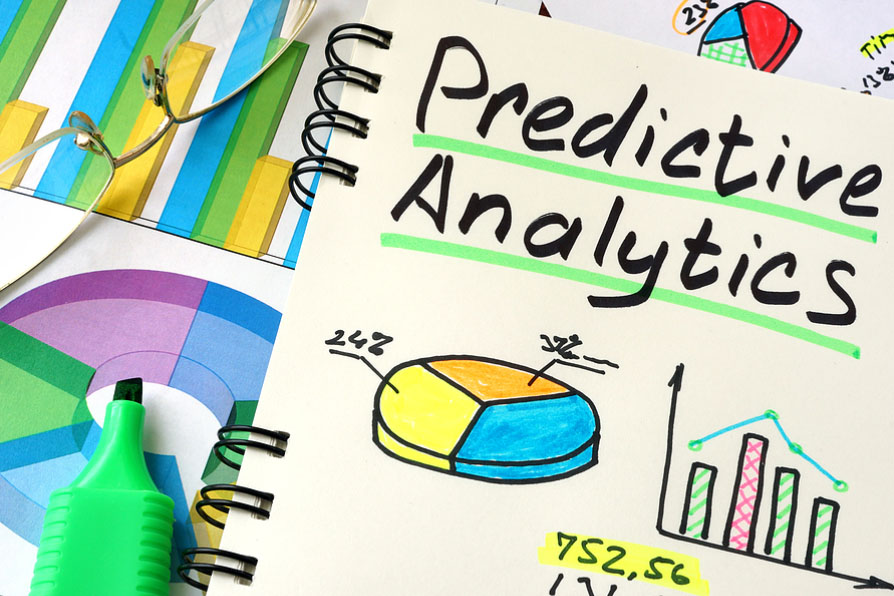Written by Sean McPheat | 

Sales Forecasting and Predictive Analytics are revolutionising the sales landscape.
These twin pillars not only offer a glimpse into the future of sales but also equip businesses with tools to be more proactive, so mastering these techniques are essential.
Sales training programmes are now integrating these concepts, ensuring that sales professionals are not just reacting to market changes but anticipating them.
Dive with us into this insightful guide and learn how to harness the power of forecasting combined with the precision of predictive analytics.

We’ll begin with a sales forecasting definition.
Sales forecasting is a process that involves estimating a company’s future revenue by predicting how much of a product or service it will sell in an upcoming time period (a week, month, quarter, year, etc.).
A sales forecast is an educated guess at how a market will respond to your organisation’s go-to-market efforts. It’s based on past sales data and the patterns and trends that can be extrapolated from it.
Sales forecasting is critical to running a successful business because it helps you to plan appropriately and make data-driven decisions regarding future operations, marketing campaigns, and resource allocation.
Accurate sales forecasting enables your business to anticipate future demand, identify potential problems and opportunities, and adjust your sales strategy as needed.
It can help you optimise other elements of your business, such as your inventory levels, production schedules, and staffing requirements. And it can also play a key role in planning your sales budget – providing your company’s finance team with the information needed to set realistic revenue targets and avoid overspending.
There are several methods of sales forecasting that you and your team can use – and it’s helpful to combine multiple methods to get a more accurate picture of the company’s finances, its future performance, etc.
The following are the most well-known and effective options:
One-time forecasting is the opposite of ARR. It predicts revenue generated by one-time sales (including individual product purchases).
Commercial forecasting is a method that focuses on the revenue generated from small and medium-sized businesses.
Enterprise forecasting focuses on the revenue that large corporations generate.
Strategic forecasting predicts the revenue generated from strategic partnerships and other high-value business relationships.
Total revenue sales forecasting predicts the total revenue a business will generate over a given period. It takes into account all revenue sources, including product sales, service fees, subscriptions, etc., as well as expenses.
Annual Recurring Revenue or ARR measures predictable, recurring revenue a company gets from its customers each year in exchange for products or services.
If your business uses a subscription model, ARR is an effective forecasting method. It includes revenue from new customers, existing customer renewals, existing customer upgrades and downgrades, and losses from customer churn.
Product line forecasting predicts revenue for every product or product line. It helps businesses determine which products drive revenue growth and which ones might need to be improved or discontinued altogether.
Historical forecasting relies on historical data, such as past sales figures, to predict future sales. It’s often used in retail businesses, as well as the banking and insurance industries.
An opportunity stage sales forecasting model utilises current customer pipelines and open opportunities to predict upcoming product demand. It focuses on factors like customer sentiment, product popularity, and the latest buying trends.
A lead value sales forecasting model relies on data from customer leads, such as contact information, past purchases, and demographics. This data provides businesses with an estimate of which leads are most likely to convert to paying customers.
In a length-of-sales cycle forecasting model, data from previous customers’ purchasing behaviour helps to forecast the time needed for potential customers to make a purchase. It looks at customer segmentation data and other factors, such as customer lifetime value, product popularity, and geographic region.
The intuitive sales forecasting method, as the name suggests, relies on intuition, experience, and judgment to make predictions for the future. It is a more qualitative approach and less data-driven.
Multivariable analysis sales forecasting models utilise multiple variables to predict upcoming demand. Some of the variables these models might use include customer demographics, economic indicators, seasonality, marketing campaigns, and competitor activity. Analysing these factors together allows businesses to identify correlations between them.

What is predictive analytics? It’s a technique that helps you determine the likelihood of future events.
You can determine the chances of something happening based on data trends and patterns collected from your customer relationship management (CRM) software.
You can use predictive analytics to make more accurate predictions regarding sales, revenue, customer behaviour, and more.
The predictive analytics process uses machine learning (ML), artificial intelligence (AI), and statistical models to evaluate current or historical data and identify patterns that may predict future behaviour. A typical predictive analytics workflow involves these steps:
If any of those steps sound too complicated, remember that you don’t have to be a data scientist to benefit from predictive analytics and sales forecasting. Many tools do the heavy lifting for you, particularly when it comes to resting and training models, and produce valuable reports that you and your team can use to make better decisions moving forward.
Businesses can use several different types of predictive analytics models, including the following:
Deciding which model to use depends on many other factors, including the amount of data you have, what you want to know from analysing that data, and the amount of detail you want included in your report.

What would it look like for a business to use predictive analytics and models like those mentioned above? Here are some real-life predictive analytics examples you can use as reference points:
Predictive analytics can play a significant role in forecasting an organisation’s future financial health. With help from historical data from previous financial statements, as well as industry data, businesses can project sales, revenue, and more.
In marketing, professionals can use consumer data for content creation, advertising, and other strategies for reaching potential customers. By examining historical behavioural data, such as website views, adding items to a cart, cart abandonment, etc., marketers can make predictions about future behaviours and plan campaigns with that data in mind.
Historical behavioural data can also help marketers predict the likelihood that a lead will move down the sales funnel from the awareness stage to the purchase stage.
For example, a marketing team could use a single linear regression model to learn that the number of content offerings a lead engages with predicts their likelihood of converting to a customer. Based on this knowledge, they can plan targeted ads at specific points throughout the customer’s lifecycle.
Businesses can also use predictive analytics to help them determine staffing needs for specific events (such as the number of sales representatives you need in the store on a particular holiday).
By evaluating data from previous holidays, including the number of sales made, the company will know how many employees to have on hand throughout the day. This information will help them avoid being under- or overstaffed.
You can also use predictive analytics to improve your company’s sales forecasting strategy.
Predictive analytics can help sales teams forecast demand more accurately, optimise pricing for various products and services, identify new sales opportunities, and improve customer satisfaction ratings. With more accurate data and more detailed reports, all of these processes become easier and more effective.
If you’re a Sales Manager take a look at our Sales Management Training.

Regardless of your industry or the types of products/services you sell, you can benefit from integrating sales forecasting and predictive analytics – and doing so sooner rather than later.
By combining predictive analytics and sales forecasting processes, you can predict future sales performance with greater accuracy.
The traditional sales forecasting process often doesn’t account for external factors that can impact a forecast, such as legislative or economic changes. Conversely, when you bring predictive analytics into the mix, you can utilise machine learning algorithms that analyse a wide range of inputs and data sets, from survey reports and economic indicators to social media sentiments.
By expanding the amount of data you have access to, you can increase the accuracy of your forecasts and make better decisions for the future.
You can experience many other benefits from combining sales forecasting and predictive analytics, including the following:
All of these advantages, when added together, will typically lead to a smoother sales process, revenue, and increased sales productivity for the company.
Using predictive analytics in sales forecasting might seem overly complex at first. It doesn’t have to be, though.
Below are some examples of how predictive analytics can improve sales forecasting processes and produce more accurate and valuable insights:
Combining sales forecasting and predictive analytics can help you identify your best customers or clients and evaluate them to determine what makes them unique. You can then use this information to find similar profiles while prospecting and increase your chances of making connections and eventually converting leads to paying customers.
Similarly, using predictive analytics in your sales forecasting strategy can also help you learn about recurring customers and gaining more repeat business. After you’ve learned about their behaviours, you can create new opportunities for upselling and cross-selling.
With the help of predictive analytics, you no longer have to throw out generic deals and sales and hope for the best. Instead, you can refine your process and develop promotions that actually lead to increased sales and better outcomes.
Predictive analytics is not going to go away anytime soon. In fact, the power of predictive analytics, particularly when it comes to forecasting sales, will only grow in the future.
Numerous businesses and departments within those businesses, from sales and marketing to customer service and human resources, will use predictive analytics to make data-driven decisions and increase their chances of seeing positive results.
The following are some examples of future trends that will shape the future of predictive analytics:
As more organisations begin using predictive analytics in their forecasting strategies, the need for real-time data will increase. As the need increases, professionals will start requiring it to ensure they’re making the most accurate predictions possible.
Synthetic or artificially generated data can help with model training and allow for more precise predictive models. Its use will become more common in the future as more organisations adopt predictive analytics solutions and start refining their processes – anything that can give businesses a competitive edge will be pursued.
Many organisations are already using machine learning and artificial intelligence to help them with their sales forecasting processes. That number is on track to increase in the coming years, especially as ML and AI become more mainstream and accessible.
Sales forecasting and predictive analytics have great power, particularly for sales teams looking to make more informed decisions and avoid wasting time on tasks that are unlikely to yield significant results.
Learning to effectively integrate these powerful tools into your sales approach requires both understanding and skill. MTD Sales is here to help you achieve that!
Our comprehensive training solutions cover a broad spectrum, including Selling Skills Training and Account Management Training.
Each program is designed to provide the knowledge and practical skills you and your team need to excel in the dynamic world of sales.
Take the first step towards transforming your sales approach with MTD Sales’ expert guidance.
As a Sales Training Provider, we can help you develop further check out our wider range of Sales Courses that can help you.
Happy selling!
Sean

Sean McPheat
Managing Director
MTD Sales Training
Updated on: 24 January, 2024
Related Articles

Search For More
